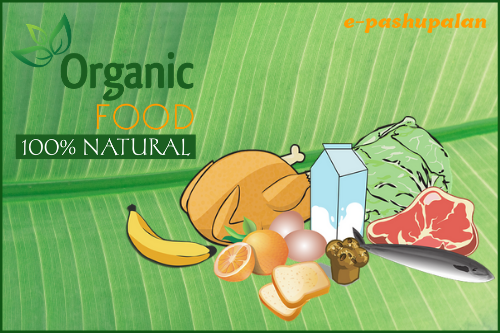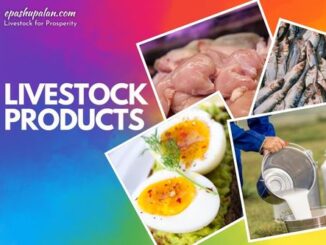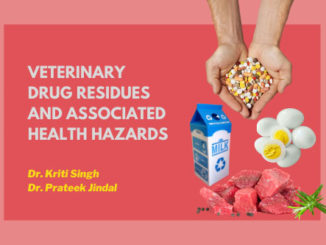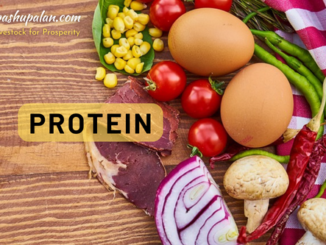Today in every household one or the other person is suffering from a number of diseases such as diabetes, hypertension, autoimmune diseases, inflammatory diseases, cancer, cardiac or developmental problems. For many of these problems, organic livestock products may offer a protective solution up to some extent. These are the products which are obtained from animals that are raised on organic pastures on the basis of their physiological and behavioral needs. In an organic system of rearing, animals are neither tethered nor confined in buildings, rather set free in open pastures, and proper attention is given to availability of fresh water, green forages and bedding materials. Under such system, all chemical based drugs, antibiotics, hormones and growth promoters are not allowed. Veterinary drugs are allowed only in non-responsive cases with proper follow up of withdrawal periods, so as to prevent drug residues in livestock products.
Organic food industry is rising at a very fast pace due to tremendous increase in their demand in last 10 to 15 years. During the year 2006, the international sale of organic foods was increased by more than two folds i.e. from 18 billion USD to 38.6 billion US Dollars. Within the domain of organic food market, major foods of animal origin constitute milk, meat, fish and eggs. In the year 2000, Indian government has launched National Program on Organic Production (NPOP) which provides complete information regarding standards, regulations and criteria for accreditation of inspection and certification bodies, the National organic logo and their regulations governing its use.

Organic milk
Organic milk (O-milk) is the milk obtained from the animal that grazes on organic pastures for the entire season (at least 120 days in a year) and receives at least 30% of its nutrition from pastures. Animal must be fed high-forage diets with minimum forage content of 60-90%. Thus there is a need of high quality forage that meets a major part of cow’s nutrient requirements especially during critical early and mid-lactation periods. The quantity of O-milk obtained from organic farming is probably less due to lower energy intake and lower dry matter yields from organic pastures than the conventional farming. The quantity of fat in O-milk may be more, less or same as that of conventional milk (C-milk). This might be due to various factors such as diet, breed of animal, stage of lactation, period of lactation, negative energy balance after calving, environment, seasonal variation (winter period), heritability, genotype etc. Following are certain health advantages of O-milk over C-milk:
- Rich source of polyunsaturated fatty acids (PUFA) with special reference to ω-3-fatty acids: O-milk possesses more desirable fatty acid composition than C-milk. Compared with C-milk, O-milk contains more PUFA with the group of ω-3-fatty acids. The higher content of ω-3-fatty acids in O-milk might be due to increased availability of fatty acids in the pasture used in the organic dairy production system. This increases the quality of O-milk due to certain beneficial effects of these fatty acids, in particular on cardiovascular, malignant and autoimmune diseases such as systemic lupus erythematosus, rheumatoid arthritis etc. Another factor is ratio of n-6 to n-3 fatty acids in milk, which determines the concentration of linoleic acid versus α-linolenic acid. Since forages are rich in linoleic acid, hence O-milk will contain lower n-6 to n-3 fatty acids ratio than the C-milk. This is typically beneficial for human health as higher amount of n-6 fatty acids in diet may cause cancer, cardiovascular, inflammatory and autoimmune diseases. To prevent from developmental and chronic health problems, people must consume foods having lower ratio of ω-6 to ω-3 fatty acids. According to an American study, O-milk contains 25% less ω-6 fatty acids and 62% more ω-3 fatty acids than the C-milk. The study reported ω-3 fatty acid concentrations in O-milk as – α-linolenic acid (60%), eicosapentaenoic acid (32%), and docosapentaenoic acid (19%) – as concentration of conjugated linoleic acid (18%). According to a meta-analysis, it has been shown that organic dairy products contain significantly higher protein, ALA, total ω-3-fatty acid, ω-3 to ω-6 ratio, cis-9, trans-11 conjugated linoleic acid, trans-11 vaccenic acid, eicosapentanoic acid, and docosapentanoic acid than the conventional products.
- Higher amounts of vitamins: As per the reports of Danish Research Institute for Dairy Industry, vitamin C content of O-milk is higher than the C-milk, which might be due to higher level of vitamin C level in organic crops in general than the conventional feeds. O-milk also contains significantly higher amounts of α-tocopherol and iron, and vitamins A and C than C-milk. Another study showed a significantly higher content of vitamin E and β-carotene in O-milk than the C-milk.
- Rich source of conjugated linoleic acid (CLA) and antioxidants: The content of CLA in organic livestock products has positive effects on human health including cancer, atherosclerosis, inflammation, and obesity, with physiological activity on lipid metabolism, immunomodulation, and oxidative stress. Since under organic farming, due to increased amounts of PUFAs and fiber in cattle feed, there is formation of CLA from biohydrogenation by rumen bacteria, hence O-milk contains 25% higher CLA than C-milk. These higher values are maintained in various dairy products such as fermented milk, butter and cheese. Thus organic dairy products could serve as a better option for providing the daily intake of 3 g/day which is considered the requirement for the proposed benefits of these fatty acids. O-milk contains about 2-3 times higher concentration of antioxidants such as lutein and zeaxanthin than C-milk. Both these antioxidants protect eyes from harmful free radicals, macular degeneration, cataract, uveitis etc.
- Low level of urea: Urea is a normal constituent of milk representing a major portion (55%) of the nonprotein nitrogen content of milk. The normal concentration of urea in milk is 18-40 mg/ According to the Indian Council of Medical research (ICMR), the presence of urea in milk above the recommended levels possess strong carcinogenic effect on humans, in addition to other health problems, including indigestion, acidity, ulcers, malfunctioning of kidneys, and osteoporosis. Since use of urea is not allowed in organic farming, the O-milk contains lower levels of urea than C-milk as reported by many investigations.
- Free from pesticide residues: According to the American Public Health Association (APHA), pesticide residues have been linked with leukemia, brain and breast cancer, learning disabilities and other disorders especially in young children. In general, O-milk contains far less pesticide residues than the C-milk, as there is absence of chemical sprays on forages in organic farming, and contamination is only mild and mainly from environmental pollution. According to a study in Mexico, it has been documented that raw bovine O-milk contains much lower levels of organochlorine pesticide residues than the permissible limit proposed by FAO/WHO/Codex Alimentarius 2006.
- Free from antibiotics residues: O-milk is unadulterated and free from any form of antibiotic residues. Antibiotic residues produce serious effects on human health including carcinogenicity, teratogenicity, reduction in reproductive performance, drug allergy, acute toxicity etc. O-milk is mostly free from antibiotic residues, because there is no excessive and irrational use of antibiotics like that of conventional farming. Under organic farming, mostly natural remedies are used to treat infections and illnesses, and if they won’t work, only then antibiotics are recommended at proper dosage and with proper withdrawal period.
- Free from hormone and chemical residues: O-milk is also free from hormone residues, as there is no direct or indirect use of hormones for animal production. On the other hand, there is excessive use of growth and reproductive hormones for efficient farming, which increase the chances of hormonal residues in C-milk. O-milk is also usually free from genetically engineered organisms, products containing genetically modified organisms (GMO), solvent extracts, fertilizers and chemical drug residues as under organic farming there is no use of growth promoters, feed supplements, GMO feeds etc. These residues may pose serious threat to human health in the form of disruption of endocrine equilibrium, genotoxicity, carcinogenicity, mutagenicity etc. Thus the choice of many consumers is to buy food which is not genetically modified that is organically produced.
- Free from aflatoxins: Among mycotoxins, aflatoxins are secondary metabolites often produced by flavus and A. parasiticus under specific temperature and humidity conditions in feeds (mostly corn and maize) during storage. Aflatoxin M 1 (mostly secreted in milk), is highly carcinogenic, genotoxic, teratogenic and immunosuppressive for humans and also it remains stable during processing of milk. O-milk contains lower levels of aflatoxin M1 and ochratoxin A than C-milk. Since under organic farming the conventional use of stored feeds is prohibited, hence there are meager chances of aflatoxin secretion in O-milk than C-milk. In this context, O-milk is considered highly safe than the C-milk.
Organic meat
Animal tissues are strongly influenced by environmental conditions besides species, genetics, gender, age at slaughter etc. Human health is benefitted by various positive aspects of meat produced under organic systems:
- Low fat and high PUFA: Organic meat (O-meat) generally contains lower fat and higher PUFA than conventional meat (C-meat). It has been observed that intramuscular lipid content is reduced from 25 to 45% in meat from animals on pastures. However, it is slightly lower (1.2-1.6%) in swine meat from the organic system than the conventional system. This study also concluded that organic feeding resulted in a significantly higher content of PUFA in the back fat (1.8%), which increased further when restricted feeding plus roughage (4%) was used. Organic poultry meat also possesses lower lipid content than conventional poultry meat. In poultry carcass, intramuscular fat is lower in breast fillet and drumstick parts than the conventional chickens. This makes these parts as food of choice for cardiac and old age weak people with higher cholesterol.
- Low ω-6:ω-3 fatty acid ratio: Organic beef meat even possesses up to five times more content of ω-3 fatty acids. It is due to ruminal biohydrogenation and greater presence of linoleic acid in the pastures which are responsible for the greater incorporation of these fatty acids in the animal tissue of cattle. Hence it can easily meet the recommended amount of 1.1 and 1.6 g/day of ω-3 fatty acids suggested for adult women and men. The higher amount of health positive factor i.e. CLA has been confirmed in tissues of animals on organic pastures than conventional systems. A research report showed that there is a significant decrease in ω-6:ω-3 fatty acid ratio from about 8:1 in conventional cattle meat to 2:1 in organic one. This could be highly beneficial to reduce cardiovascular disease risk.
- Low cholesterol: O-meat possesses lower cholesterol than C-meat from cattle and chicken. Hence it serves as healthier meat for heart patients, convalescent and old age people. Overall reports analysis have shown that organic meat possesses 23% higher PUFA than conventional meat.
- Less risk of pathogenic bacteria: Since there is no consistent use of antibiotics under organic farming system, hence meat produced in such a way will probably have less risk of contamination by certain dreadful bacteria particularly, coli O157: H7, Salmonella spp etc. The ‘organic’ label itself provides assurance that no food ingredient is subject to irradiation and that genetically modified organisms.
The above observations suggest that organic meat present a healthy profile for people of all ages since higher CLA and the lower ω-6:ω-3 ratio is beneficial characteristics for reducing the risk of chronic diseases, such as cardiovascular and other chronic inflammatory diseases.
Organic eggs
Eggs are considered highly nutritious, relatively cheaper, unadulterated food with highest biological value and digestibility index. Organic egg (O-egg) production involves housing, management, welfare, health care and feeding procedures as per certification by the licensing authorities. The quality of O-eggs is affected by various parameters including genotype, type of diet, forage material, environmental conditions etc. In general O-eggs contain higher amount of protein, higher whipping capacity and foam consistency, and lower yolk to albumen ratio than C-eggs. O-eggs provide following health benefits over conventional eggs (C-eggs):
- Rich source of PUFA: O-eggs contain higher amount of ω-3 fatty acids (6.2-7.7 g/kg yolk) than C-eggs. According to a study, the concentration of ω-3 fatty acids was significantly higher in O-eggs than the eggs obtained from hens raised in cages, barns and free range systems. According to FAO, n-3 PUFA such as EPA and DHA reduce the risk of chronic diseases and the lower acceptable intake for adults is 250 mg/day.
- Low fats and saturated fatty acids: O-eggs contain fewer lipids and saturated fatty acids than C-eggs. According to a study, there was a significant difference in the concentration of saturated fatty acids levels, such as 60-68 g and 82.1-85.7 g/kg yolk in organic eggs and in conventional husbandry system, respectively. Thus potential health benefits of O-eggs include lower saturated fatty acids, higher ω-3 fatty acids and lower atherogenic index.
- More minerals and vitamins: In general O-eggs are rich sources of Fe, Zn and Se than C-eggs. According to a study, Fe content of O-eggs (about 2 mg% fresh matter) was found higher than C-eggs (about 1.6 mg% fresh matter). O-eggs also contain about 7% more potassium than C-eggs. Also there is more amount of α-tocopherol and α-linoleic acid in egg yolks of Leghorn hens kept in a free-range system.
- Higher Haugh unit: Haugh unit (HU) of an egg determines its quality, and is determined when height of the albumen is correlated with weight of egg on a logarithmic scale. Higher is the HU, better is the egg quality in terms of freshness, thickness of egg white albumin etc. According to a study, HU of O-eggs (65.26) was significantly higher than the eggs obtained from hens raised in cages (48.39), barns (58.12) and free range systems (55.40).
Organic fish
Organic aquaculture has also attracted the attention of consumers, environmental advocates and entrepreneurial innovators. Organically cultured sea foods include carps, catfish, tilapias, salmon, shrimps, mussels, perches, milkfish, trouts, sea bream, fresh water prawns, sea bass etc. In organic fish farming, organic feeds can be formulated by various feed ingredients of plant origin which conform to organic standards. As per standards of organic production, there is complete restriction on use of GMOs and products produced from or by GMOs, antibiotics, hormones, pesticides, growth-enhancing substances and synthetic feed additives such as synthetic amino acids and chemo-synthetic pigments for culturing of organic fish. As far as the health benefits of organic fish over conventional fish are concerned, there is lack of scientific reports and evidences. However, it seems that organic fish may have certain advantages over conventionally produced fish in terms of free from hormone, chemical and pesticide residues, but this aspect needs further authentication. Thus there is need to conduct controlled research on the superiority of organic fish over conventional fish in terms of nutritional value also.
References
- Benbrook, C.M., Butler, G., Latif, M.A., Leifert, C. and Davis, D.R. 2013. Organic production enhances milk nutritional quality by shifting fatty acid composition: A United States–wide, 18-month study. PloS one. 8(12): e82429.
- Bergamo, P., Fedele, E., Iannibelli, L. and Marzillo, G. 2003. Fat-soluble vitamin contents and fatty acid composition in organic and conventional Italian dairy products. Food Chemistry. 82: 625-631.
- Carvalho, E.B.T.D., Melo, I.L.P.D. and Mancini-Filho, J. 2010. Chemical and physiological aspects of isomers of conjugated fatty acids. Food Science and Technology. 30(2): 295-307.
- Cintra, R.M.G., Malheiros, J.M., Ferraz, A.P.R. and Chardulo, L.A.L. 2018. A review of nutritional characteristics of organic animal foods: eggs, milk, and meat. Nutrition and Food Technology: Open Access. 4(1).
- Creppy, E.E. 2002. Update of survey, regulation and toxic effects of mycotoxins in Europe. Toxicology Letters. 127: 19e28.
- FAO. 2010. Fats and fatty acids in human nutrition FAO report of an expert consultation. Rome: FAO.
- Hansen, L.L., Claudi-Magnussen, C., Jensen, S.K. and Andersen, H.J. 2006. Effect of organic pig production systems on performance and meat quality. Meat Science. 74(4): 605-615.
- Kouba, M. 2003. Quality of organic animal products. Livestock Production Science. 80(1-2): 33-40.
- Kourimska, L., Legarova, V., Panovska, Z. and Panek, J. 2014. Quality of cow’s milk from organic and conventional farming. Czech Journal of Food Sciences. 32(4): 398-405.
- Kumar, N.M., Kangaraju, P., Pandian, C. and Srinivasan, G. 2017. Organic broiler meat production in India – an overview. International Journal of Livestock Research. 7(11): 23-31.
- Kummeling, I., Thijs, C., Huber, M., Vijver, L.P., Snijders, B.E., Penders, J., Stelma, F., Brandt, P.A. and Dagnelie, P.C. 2008. Consumption of organic foods and risk of atopic disease during the first 2 years of life in the Netherlands. British Journal of Nutrition. 99(3): 598-605.
- Lopez-Bote, C.J., Sanz Arias, A.I., Rey, A.I., Castano, A., Isabel, B. and Thos, J. 1998. Effect of free-range feeding on n-3 fatty acid and α-tocopherol content and oxidative stability of eggs. Anim Feed Science and Technology. 72: 33-38.
- Lordelo, M., Fernandes, E., Bessa, R.J.B. and Alves, S.P. 2017. Quality of eggs from different laying hen production systems, from indigenous breeds and specialty eggs. Poultry Science. 96(5): 1485-1491.
- Matt, D., Veromann, E. and Luik, A. 2009. Effect of housing systems on biochemical composition of chicken eggs. Agronomy Research. 7(2): 662-667.
- Mizumoto, E.M., Canniatti-Brazaca, S.G., Machado, F.M.V.F. 2008. Chemical and sensorial evaluation of eggs obtained by different production systems. Food Science and Technology. 28: 60-65.
- Nazareth, J., Shaw, A., Delate, K. and Turnbull, R. 2019. Food safety considerations in integrated organic crop–livestock systems: prevalence of Salmonella spp. and E. coli O157: H7 in organically raised cattle and organic feed. Renewable Agriculture and Food Systems. 1-9.
- Oruc, H.H., Cibik, R., Yilmaz, E. and Kalkanli, O. 2006. Distribution and stability of aflatoxin M1 during processing and ripening of traditional white pickled cheese. Food Additives and Contaminants. 23: 190-195.
- Palupi, E., Jayanegara, A., Ploeger, A. and Kahl, J. 2012. Comparison of nutritional quality between conventional and organic dairy products: a meta-analysis. Journal of Science of Food and Agriculture. 92: 2774-2781.
- Popovic-Vranjes, A., Savic, M., Pejanovic, R., Jovanovic, S. and Krajinovic, G. 2011. The effect of organic milk production on certain milk quality parameters. Acta Veterinaria-Beograd. 61(4): 415-421.
- Prandini, A., Sigolo, S. and Piva, G. 2009. Conjugated linoleic acid (CLA) and fatty acid composition of milk, curd and Grana Padano cheese in conventional and organic farming systems. The Journal of Dairy Research. 76(3): 278-282.
- Singh, P. and Gandhi, N. 2015. Milk preservatives and adulterants: processing, regulatory and safety issues. Food Reviews International. 31(3): 236-261.
- Singh, P., Singh, T.P. and Gandhi, N. 2018. Prevention of lipid oxidation in muscle foods by milk proteins and peptides: a review. Food Reviews International. 34(3): 226-247.
- Vallone, L., Boscariol, D. and Dragoni, I. 2006. Aflatoxins in organic milk and dairy products. Veterinary Research Communications. 30(Suppl. 1): 369-370.
- Zagorska, J. and Ciprovica I. 2008. The chemical composition of organic and conventional milk in Latvia. In: Proceedings 3rd Baltic Conference on Food Science and Technology Foodbalt-2008, Latvia University of Agriculture, Jelgava: 10-14.






Be the first to comment